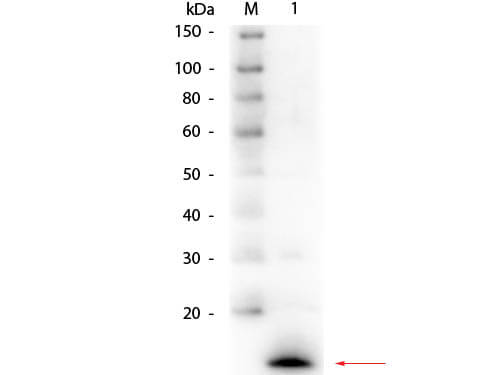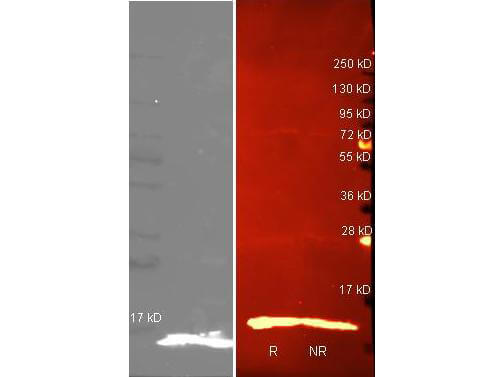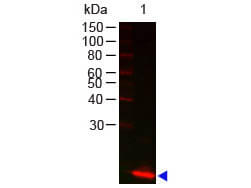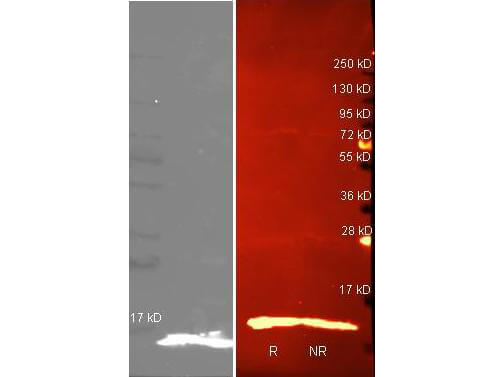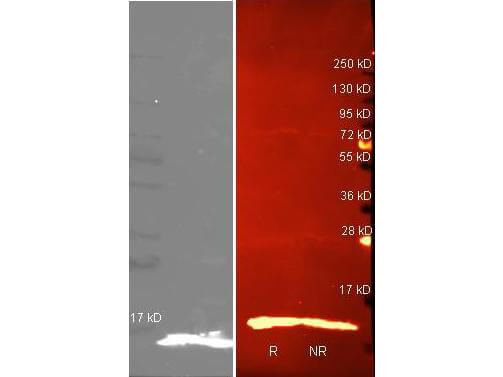Datasheet is currently unavailable. Try again or CONTACT US
Lysozyme Antibody
Rabbit Polyclonal
5 References
200-401-072S
200-401-072
25 µL
100 µg
Liquid (sterile filtered)
Liquid (sterile filtered)
WB, ELISA, FC, Dot Blot
Chicken
Rabbit
Shipping info:
$50.00 to US & $70.00 to Canada for most products. Final costs are calculated at checkout.
Product Details
Anti-Lysozyme (Hen Egg White) (RABBIT) Antibody - 200-401-072
rabbit anti-Lysozyme Antibody, 1 4 beta n acetylmuramidase c antibody, EC 3.2.1.17 antibody, LYZ antibody, Lysozyme C antibody, Lysozyme C precursor antibody, LZM antibody, Hen Egg White
Rabbit
Polyclonal
IgG
Target Details
LYZ - View All LYZ Products
Chicken
Native Protein
This purified antibody was prepared from whole rabbit serum produced by repeated immunizations with full length protein corresponding to amino acids 1-129 of Hen Egg White Lysozyme.
This purified antibody is directed against lysozyme from hen egg white protein. This product is an IgG fraction antibody purified from monospecific antiserum by a multi-step process, which includes delipidation, salt fractionation and ion exchange chromatography followed by extensive dialysis against the buffer stated above. Assay by immunoelectrophoresis resulted in a single precipitin arc against anti-Rabbit Serum as well as purified and partially purified Lysozyme (Hen Egg White). A BLAST analysis was used to suggest that this antibody would react with all forms of lysozyme from chicken, including precursor as well as A and B chains. Chains designated as M, L, F, C, Y and D also show 100% sequence homology. Lysozyme from quail and pheasant are also reported to be 100% identical with HEW lysozyme. Cross reactivity against lysozyme from other sources may occur but has not been specifically determined.
Application Details
Dot Blot, ELISA, WB
FC
- View References
Anti-Lysozyme Hen Egg White purified antibody has been tested for use in ELISA and western blot. Specific conditions for reactivity should be optimized by the end user. Expect a band at ~14 kDa in size corresponding to lysozyme by western blotting in the appropriate cell lysate or extract.
Formulation
1.0 mg/ml by UV absorbance at 280 nm
0.02 M Potassium Phosphate, 0.15 M Sodium Chloride, pH 7.2
0.01% (w/v) Sodium Azide
None
Shipping & Handling
Dry Ice
Store vial at -20° C prior to opening. Aliquot contents and freeze at -20° C or below for extended storage. Avoid cycles of freezing and thawing. Centrifuge product if not completely clear after standing at room temperature. This product is stable for several weeks at 4° C as an undiluted liquid. Dilute only prior to immediate use.
Expiration date is one (1) year from date of receipt.
Lysozyme is a relatively small (129 AA) secretory enzyme that catalyzes the hydrolysis of β-1,4 glucosidic linkages between N-acetylmuramic acid (NAM) and N-acetylglucosamine (NAG) comprising the cell walls of bacteria and to a lesser degree chitin oligomers. Lysozyme is common in animals and plants. In birds, lysozyme is also an exceptionally abundant protein in egg whites. Its biological function in fowl eggs is unclear. Hen egg white lysozyme ''c'' is the most commonly studied form and source of the enzyme. Lysozyme from domestic goose is designated lysozyme ''g''. Lysozyme is also found in vertebrates, including human, mostly in secretions and certain tissues, such as saliva, tears, milk, cervical mucus, leucocytes, kidneys and urine, where it probably serves as an anti-bacterial agent by digesting and weakening the rigid bacterial cell wall, thereby rendering the bacteria susceptible to osmotic lysis. Plant lysozyme is found in ficus and papaya latex, and is chemically distinct from the egg white enzyme.
Klaska IP et al. (2023). Targeted delivery of autoantigen to dendritic cells prevents development of spontaneous uveitis. Front Immunol.
Applications
WB, IB, PCA
Liu YH et al. (2018). Partial retinal photoreceptor loss in a transgenic mouse model associated with reduced levels of interphotoreceptor retinol binding protein (IRBP, RBP3). Exp Eye Res.
Applications
WB, IB, PCA
Mendez IZR et al. (2007). Potentiation of the immune response to non-adsorbed antigens by aluminum-containing adjuvants. Vaccine.
Applications
E, EIA
Eric H Ekland et al. (2004). Requirements for follicular exclusion and competitive elimination of autoantigen-binding B cells. J Immunol .
Applications
FC, FACS, FLOW
Pleschberger M et al. (2003). Generation of a functional monomolecular protein lattice consisting of an s-layer fusion protein comprising the variable domain of a camel heavy chain antibody. Bioconjug Chem.
Applications
Dot Blot Assay
This product is for research use only and is not intended for therapeutic or diagnostic applications. Please contact a technical service representative for more information. All products of animal origin manufactured by Rockland Immunochemicals are derived from starting materials of North American origin. Collection was performed in United States Department of Agriculture (USDA) inspected facilities and all materials have been inspected and certified to be free of disease and suitable for exportation. All properties listed are typical characteristics and are not specifications. All suggestions and data are offered in good faith but without guarantee as conditions and methods of use of our products are beyond our control. All claims must be made within 30 days following the date of delivery. The prospective user must determine the suitability of our materials before adopting them on a commercial scale. Suggested uses of our products are not recommendations to use our products in violation of any patent or as a license under any patent of Rockland Immunochemicals, Inc. If you require a commercial license to use this material and do not have one, then return this material, unopened to: Rockland Inc., P.O. BOX 5199, Limerick, Pennsylvania, USA.

